Key takeaways:
- Inclusive design aims to create accessible experiences for all individuals, acknowledging diverse user needs, including those with disabilities.
- Key principles include flexible layouts, alternative text for images, and consistent navigation, enhancing usability for everyone.
- Implementing inclusive design techniques like color contrast and keyboard navigation significantly improves user engagement and satisfaction.
- Collaboration with users from diverse backgrounds and ongoing feedback is crucial for continual improvement and making informed design decisions.
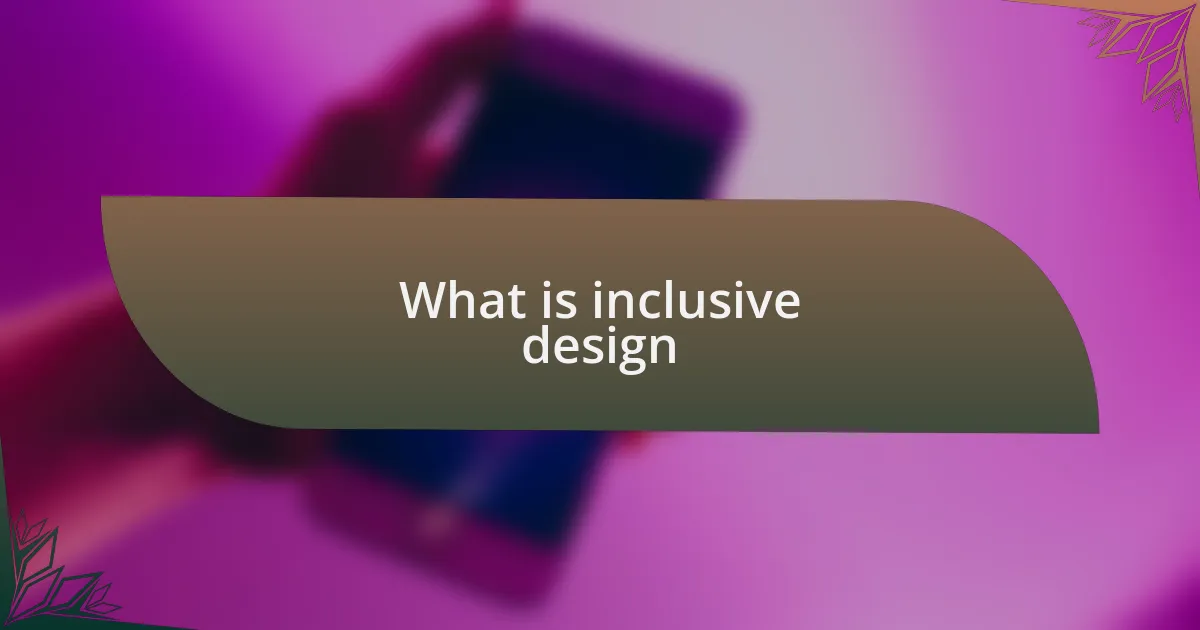
What is inclusive design
Inclusive design is fundamentally about creating experiences that are accessible to all individuals, regardless of their backgrounds or abilities. When I first stumbled upon this concept during a project, it struck me how often we overlook the diverse needs of users. Have you ever tried to navigate a website that seemed designed only for a specific group? It can be frustrating, right?
At its core, inclusive design involves understanding the different ways people interact with technology. I vividly recall an instance when a visually impaired colleague shared how frustrating it was to use a site that wasn’t designed with accessibility in mind. This made me realize that enhancing a website’s usability goes beyond aesthetics; it’s about ensuring everyone can engage with content effortlessly.
I’ve learned that inclusive design extends to various aspects, including color contrast, navigation simplicity, and clear language use. It invites us to consider: how would my grandma use this website? This mindset not only broadens the audience but fosters a sense of belonging, showing that every user’s experience is valued. Ultimately, inclusive design is a commitment to empathy and understanding in our creations.
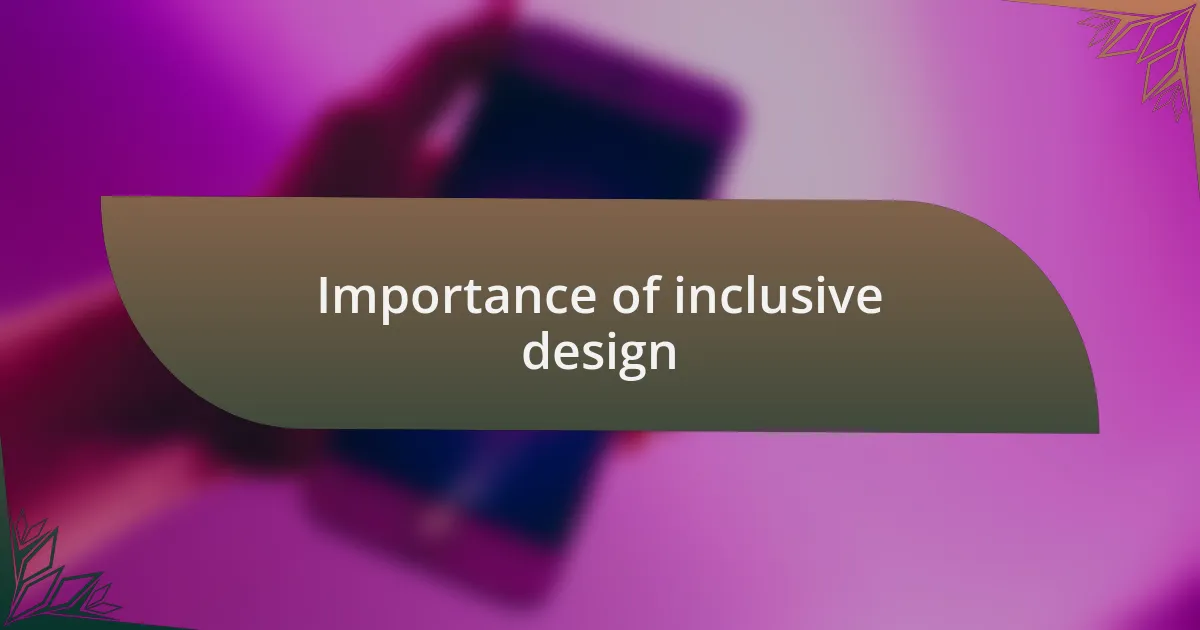
Importance of inclusive design
Inclusive design is essential because it ensures that everyone, regardless of ability, can navigate and interact with a website. I remember a project where we revamped a client’s site after receiving feedback from users with disabilities. The transformation was remarkable, and those who previously faced barriers expressed gratitude that their needs were finally considered.
Understanding the importance of inclusive design goes beyond compliance; it builds community and trust. Reflecting on my experiences, I often think about users with varying literacy levels or those who rely on screen readers. How meaningful is it to create a space where everyone feels welcome? That sense of acceptance encourages users to return and engage more deeply.
Moreover, inclusive design enhances overall user experience for everyone, not just those who require accommodations. I once saw a parent struggling to help their child with a learning disability navigate an educational site. When we integrate universal design principles, we empower all users to connect with content in a way that resonates with them, enriching their online journey.
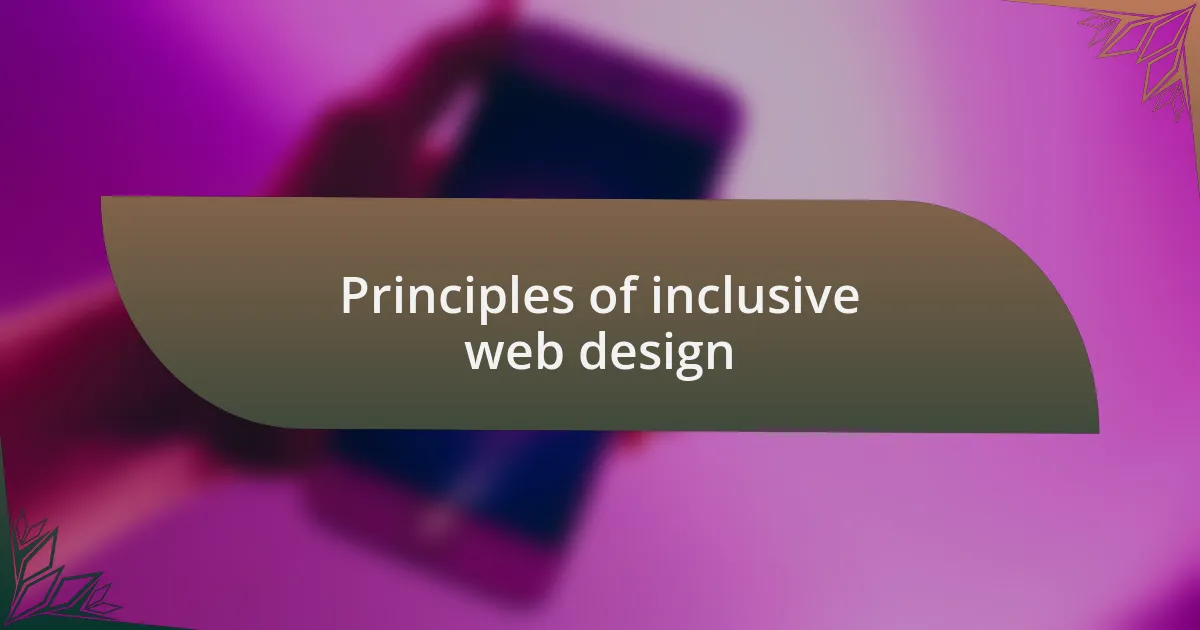
Principles of inclusive web design
The principles of inclusive web design are rooted in understanding diverse user needs. For instance, while working on a project for an educational platform, I discovered the power of flexible layouts. A visually impaired user shared how a simple change in text size made a world of difference. This feedback drove home the point that design choices should prioritize accessibility first and foremost.
Another key principle is providing alternative text for images. I once helped redesign a gallery website where visual content was front and center. By adding descriptions for each image, we opened up the site to users who rely on screen readers. It was inspiring to witness how the inclusion of this small detail transformed the user experience for so many. What if every image told a story to everyone? That notion truly encapsulates the essence of inclusive design.
Lastly, consistency in navigation plays a crucial role. During a recent client visit, I noticed a user struggling to find information due to varied menu styles across pages. By standardizing navigation elements, we not only made the site friendlier for those with cognitive disabilities but also simplified the experience for all users. Isn’t it fascinating how thoughtful design can enhance usability for everyone? It reinforces the idea that inclusivity benefits all, making it a principle worth prioritizing in every project.
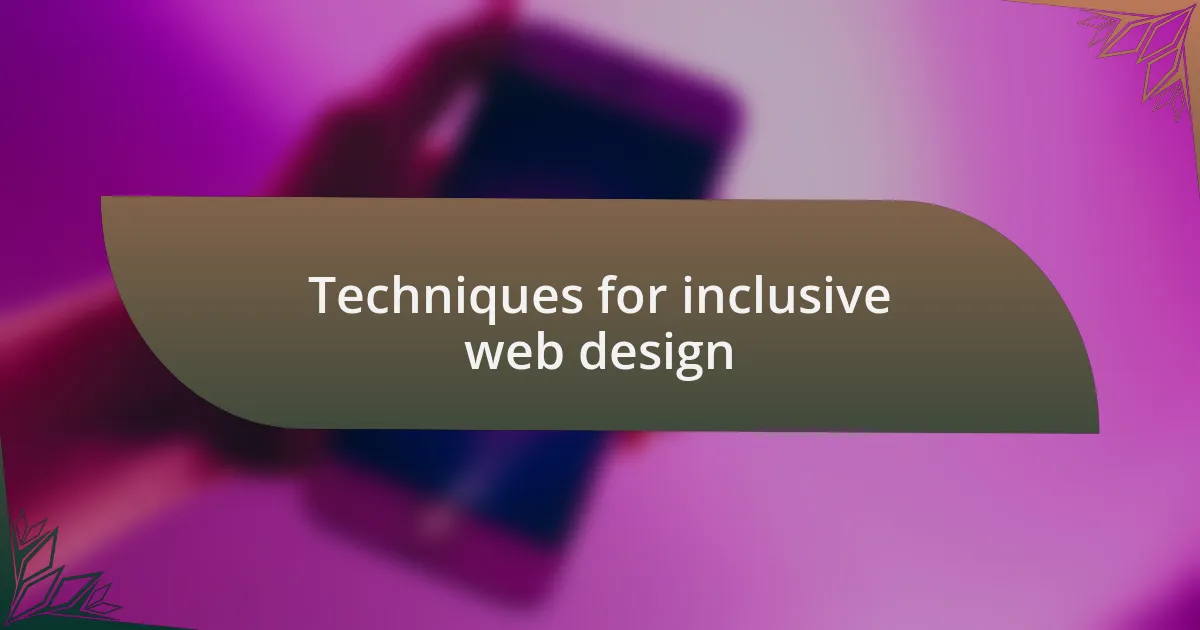
Techniques for inclusive web design
One technique I’ve found invaluable is the use of color contrast, particularly when designing for users with visual impairments. In one project, I experimented with color palettes that met accessibility standards but still evoked the brand’s essence. Seeing the delight on a user’s face when they could effortlessly read text against a contrasting background was a powerful reminder that thoughtful choices can elevate an entire experience.
Another approach involves incorporating keyboard navigation. I remember a user who couldn’t use a mouse struggling to engage with complex forms. By adding keyboard shortcuts and ensuring all functionalities were accessible via tab actions, I saw an immediate improvement in user engagement. This shift raised a thought: How often do we consider the different ways people interact with our designs, and what more can we do to accommodate every user?
Lastly, integrating user testing from diverse groups has been a game-changer for me. I vividly recall a session where a group of elderly users provided feedback on a senior-friendly interface I had designed. Their suggestions were simple yet profound, emphasizing the importance of large buttons and clear language. This experience reinforced the idea that involving users from varied backgrounds not only enhances design quality but creates a more meaningful connection to the final product. Isn’t it amazing how collaboration can unveil insights we might overlook otherwise?
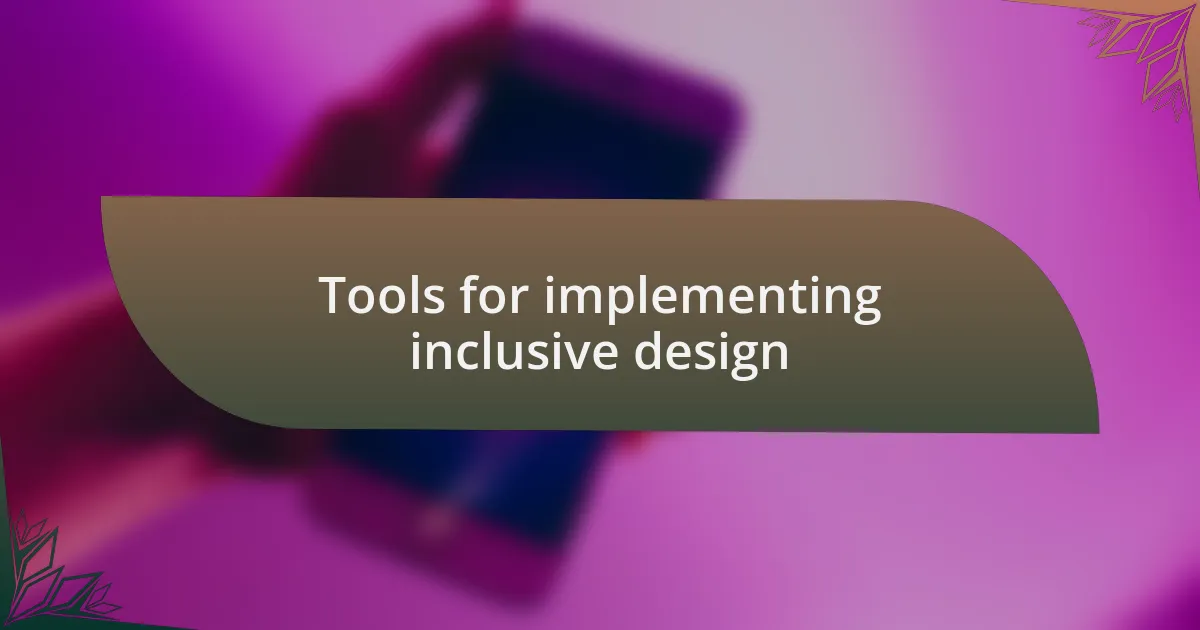
Tools for implementing inclusive design
To implement inclusive design effectively, a variety of tools can be invaluable. One essential tool I’ve come to appreciate is screen reader software. While working on a project, I had the opportunity to witness how accurately crafted alt text for images made a profound difference for users who relied on screen readers. I remember the moment when a user shared how it felt empowering to navigate a website seamlessly, contrasting with their previous experiences. It left me wondering: are we doing enough to prioritize this aspect?
Another tool I often utilize is accessibility checkers, such as WAVE or Axe. I recall a time when a quick audit revealed several overlooked issues, like missing labels on form fields. The realization hit me hard; it’s easy to fall into the trap of assuming our designs are accessible. This moment reinforced my belief that regular checks are not just a box to tick but a commit to enhancing the digital experience for everyone.
Lastly, I’ve started incorporating user feedback tools like surveys and interviews after launch, specifically targeting individuals with disabilities. On one occasion, a visually impaired user pointed out that our navigation was intuitive, yet they struggled with color palettes. This dialogue opened avenues for improvement that I hadn’t anticipated. It’s a reminder to consider, how often do we reach out for feedback from the very people we aim to serve?
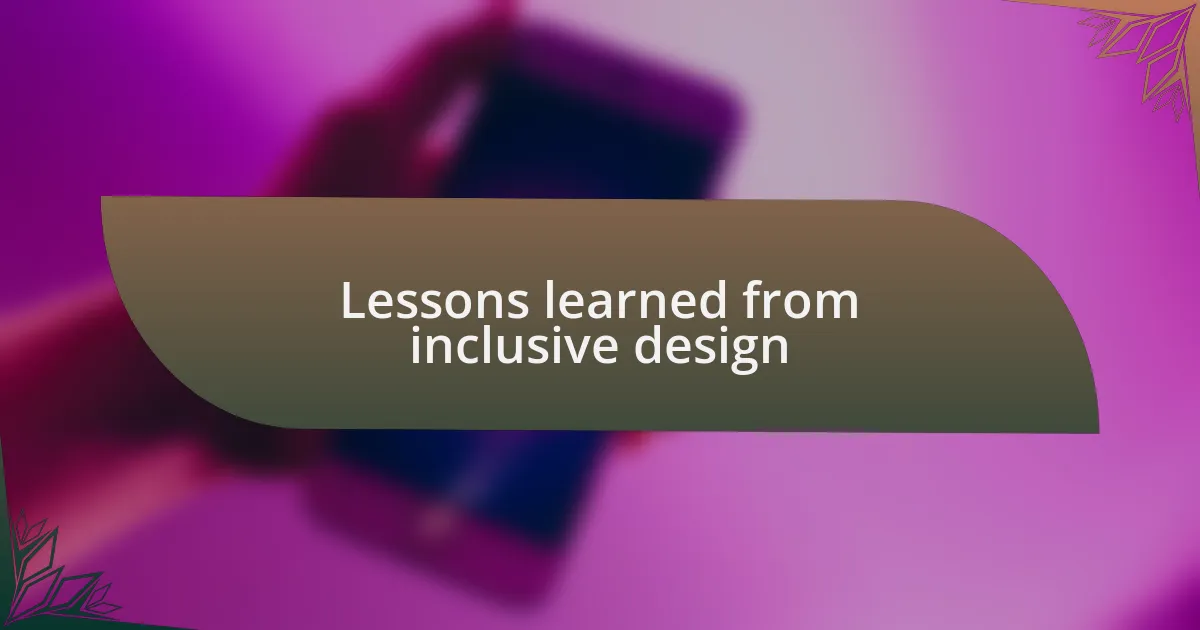
Lessons learned from inclusive design
Embracing inclusive design has taught me that the user experience is not one-size-fits-all. I vividly recall working on a project where we created adjustable text sizes. A user with low vision remarked how this simple feature transformed their ability to engage with content. It struck me hard how small adjustments can unlock access for many people, prompting the question: are we truly considering varied needs in our designs?
One lesson that stands out is the importance of collaborating with individuals from diverse backgrounds. I remember a workshop where we included users with disabilities in the design process. Their candid feedback on our color choices and layout was eye-opening. It made me realize how valuable it is to listen to the voices of those who experience our designs differently.
Lastly, I’ve learned that inclusive design is an ongoing journey rather than a final destination. During a recent project, I hesitated to push back on a stakeholder’s preferred aesthetic, fearing it might detract from accessibility. However, advocating for a design that catered to diverse needs resulted in a product that not only looked good but genuinely resonated with its audience. This experience left me wondering: how can we balance aesthetics with accessibility in a way that serves everyone?